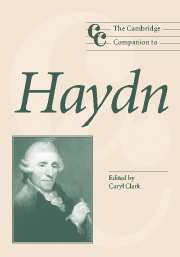Book contents
- Frontmatter
- Part I Haydn in context
- Part II Stylistic and interpretive contexts
- Part III Genres
- Part IV Performance and reception
- 14 A composer, his dedicatee, her instrument, and I: thoughts on performing Haydn's keyboard sonatas
- 15 Haydn and posterity: the long nineteenth century
- 16 The kitten and the tiger: Tovey's Haydn
- 17 Recorded performances: a symphonic study
- Notes
- Bibliography
- Index
16 - The kitten and the tiger: Tovey's Haydn
from Part IV - Performance and reception
Published online by Cambridge University Press: 28 September 2011
- Frontmatter
- Part I Haydn in context
- Part II Stylistic and interpretive contexts
- Part III Genres
- Part IV Performance and reception
- 14 A composer, his dedicatee, her instrument, and I: thoughts on performing Haydn's keyboard sonatas
- 15 Haydn and posterity: the long nineteenth century
- 16 The kitten and the tiger: Tovey's Haydn
- 17 Recorded performances: a symphonic study
- Notes
- Bibliography
- Index
Summary
One of the standard ways for a critic to set up an argument is to state that the popular image of an artist is misguided. The rhetorical manoeuvre cuts two ways, or would were it not so overused. It sets the critic up as a thoughtful expert and clears the ground for the construction of a contrary image that claims to be truer to life. What remains for both the straw man and the thoughtful expert is the necessity of the image, a narrative trope that tags the artist with certain identifying traits and provides a ready means of orientation for both apprehending the artist's work and communicating about it in social contexts. It would be easy to dismiss these images as packaging or window-dressing, both of which they are, but it would also be a mistake. The images are as unavoidable as they are useful, the basic coinage of the pragmatics of art. They are also symptomatic of the cultural trends that they serve or challenge. None of them should be believed, exactly, but all of them should be taken seriously.
This is perhaps especially true with respect to Haydn, whose fortunes, at least in the English-speaking world, have been tied exceptionally closely to a pair of images with remarkable staying power.
- Type
- Chapter
- Information
- The Cambridge Companion to Haydn , pp. 239 - 248Publisher: Cambridge University PressPrint publication year: 2005
- 1
- Cited by

